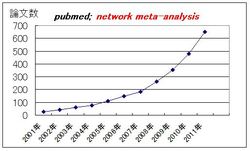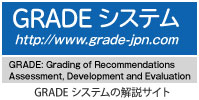エビデンスの非直接性(indirectness)は,従来の「外的妥当性」(external validity)(一般化可能性generalizability と同義)と同様のものである。indirectnessには、2つのタイプがある。
エビデンスの非直接性(GRADEハンドブック)
| エビデンスの非直接性 |
|
1. 非直接的な比較 (*)- 介入AとBの比較ができないために、AをCと比較し、BをCと比較したときがこれに当てはまる。このような研究では、A対Bの効果の大きさを非直接的に比較できる。しかし、このようなエビデンスは、AとBの直接的比較が提供する質よりも低いものである。 |
|
2. 非直接的な集団、介入、比較、またはアウトカム – ガイドラインパネルまたはシステマティック・レビューの著者が取り組む疑問が、集団、介入、比較、またはアウトカムに関する入手可能なエビデンスと違っている。 |
(*)非直接的な比較:
例; ネットワークメタアナリシス(NMA)
個々の試験に発表されている効果推定値とその信頼区間を利用して、論文中で直接比較していない治療群間の差を推定する方法(mixed treatment comparison, multiple treatments meta-analysisともいう)。通常は、NMAのエビデンスの質はindirectnessのために、1~2段階グレードダウンになる。
注意:
Surrogate outcomesの全てがエビデンスの質低下ではない
Rarely, surrogates are sufficiently well established that review authors or guideline panelists should choose not to rate down quality of evidence for indirectness. In our view, this should be restricted to situations in which, within the same class of drug (e.g., beta-blockers, calcium antagonists, diuretics, bisphosphonates), changes in the surrogate have repeatedly proved closely related to changes in the patient-important outcome in the context of RCTs. (J Clin Epidemiology 64, 1303-1310, 2011
シナリオにおける、2つのアウトカムに関する評価:
・全死亡率: no serious indirectness
・大出血: no serious indirectness




